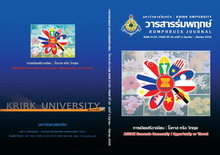ทิศทางการเรียนการสอนผ่านสื่ออิเล็กทรอนิกส์ (e-Learning) ในอาเซียน
Main Article Content
Abstract
Teaching Learning Direction Via e-Learning in ASEAN
The ASEAN leaders agree to promote joint efforts in strengthening the national development strategies in the region by using Information and Communication Technology (ICT) to maintain economic growth. To create ability to complete in the global market as well as to enhance the quality of life, it is mandatory to support human resources to acquire the knowledge of ICT to be able to get the access of services, and resources from all over the world. However, such development could not be achieved in all areas since many countries in the region were not capable to build enough schools to accommodate the needs of their population living in the rural areas, or the needs of the work force groups. e-Learning seemed to be the easiest and cheapest way to transfer knowledge and to create capable human resources in the ASEAN community. This study emphasized on the ASEAN member countries which give priority to prepare the necessary infrastructure throughout the region and high skilled ICT manpower to support a digital society. However, the results could not be achieved in a short time. There were obstacles in several areas, for example : learning resources ; capability of instructor and people’s attitudes towards ICT. These could be treated as challenges, and capability of ASEAN cooperation to find solution under mutual support.
Article Details
Every article published in the Romphruek Journal of the Humanities and Social Sciences is the opinion and point of view of the authors. Thery're not the viewpoint of Krirk University or the editored department. Any part or all of the articles for pablication must be clearly cited.

